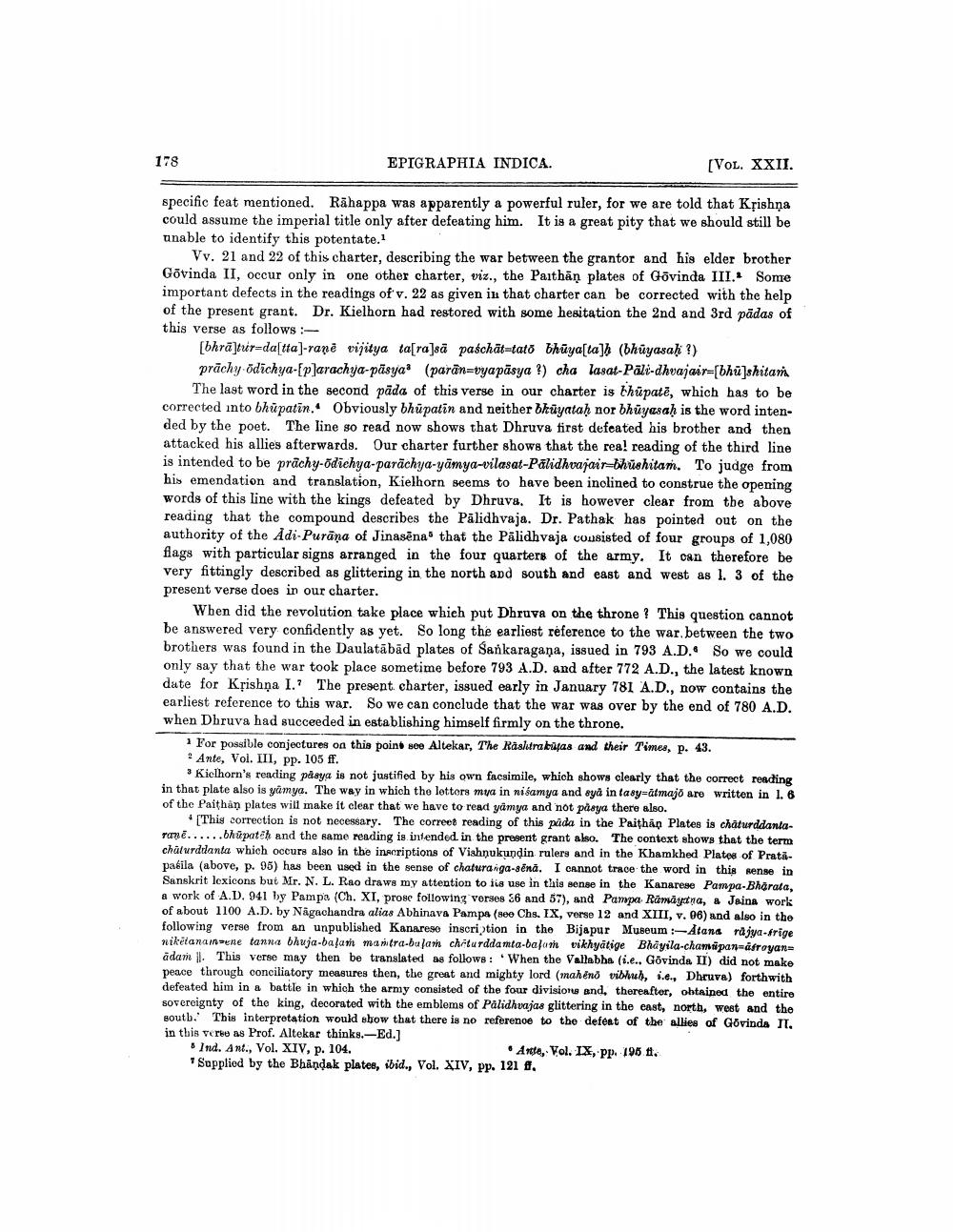________________
178
EPIGRAPHIA INDICA.
(VOL. XXII.
specific feat mentioned. Rāhappa was apparently a powerful ruler, for we are told that Kțishņa could assume the imperial title only after defeating him. It is a great pity that we should still be unable to identify this potentate.1
Vv. 21 and 22 of this charter, describing the war between the grantor and his elder brother Govinda II, occur only in one other charter, viz., the Paithāņ plates of Govinda III. Some important defects in the readings of v. 22 as given in that charter can be corrected with the help of the present grant. Dr. Kielhorn had restored with some hesitation the 2nd and 3rd pädas of this verse as follows:
[bhrāJour-dastta)-rane vijitya ta[ra]sā paschättato bhūya[tah (bhūyasaḥ ?) prachy odichya-fpJarachya-pāsya* (parān=vyapāsya ?) cha lasat-Päli-dhvajair-[bhu]shitam
The last word in the second pada of this verse in our charter is thüpatē, which has to be corrected into bhupatin.. Obviously bhüpatin and neither bküyataḥ nor bhūyasah is the word intended by the poet. The line so read now shows that Dhruva first defeated his brother and then attacked his allies afterwards. Our charter further shows that the real reading of the third line is intended to be prachy-odichya-parächya-yāmya-vilasat-Pálidhvajair-bhúshitam. To judge from his emendation and translation, Kielhorn seems to have been inclined to construe the opening words of this line with the kings defeated by Dhruva. It is however clear from the above reading that the compound describes the Pālidhvaja. Dr. Pathak has pointed out on the authority of the Adi-Purāna of Jinasena that the Palidhvaja consisted of four groups of 1,080 flags with particular signs arranged in the four quarters of the army. It can therefore be very fittingly described as glittering in the north and south and east and west as l. 3 of the present verse does in our charter.
When did the revolution take place which put Dhruva on the throne ? This question cannot be answered very confidently as yet. So long the earliest reference to the war between the two brothers was found in the Daulatābād plates of Sankaragana, issued in 793 A.D. So we could only say that the war took place sometime before 793 A.D. and after 772 A.D., the latest known date for Kțishņa I.? The present charter, issued early in January 781 A.D., now contains the earliest reference to this war. So we can conclude that the war was over by the end of 780 A.D. when Dhruva had succeeded in establishing himself firmly on the throne.
1 For possible conjectures on this point see Altekar, The Raslutrabūgas and their l'imes, p. 43. ? Ante, Vol. III, pp. 105 ff.
Kiclhorn's reading pasya is not justified by his own facsimile, which shows clearly that the correct reading in that plate also is yamya. The way in which the letters mya in nibamya and syà in tasy=ātmajo are written in 1. 6 of the Paithan plates will make it clear that we have to read yamya and not pasya there also.
[This correction is not necessary. The correct reading of this pada in the Paithan Plates is chaturddantarane......bhüpatch and the same reading is intended in the present grant also. The context shows that the term chaturddanta which occurs also in the inscriptions of Vishnukundin rulers and in the Khamkhed Plates of Pratapabila (above, p. 95) has been used in the sense of chaturanga-sena. I cannot trace the word in this sense in Sanskrit lexicons but Mr. N. L. Rao draws my attention to its use in this sense in the Kanarese Pampa-Bharata, a work of A.D. 941 by Pampa (Ch. XI, prose following verses 36 and 57), and Pampa Rāmāyana, a Jaina work of about 1100 A.D. by Nägachandra alias Abhinava Pampa (see Chs. IX, verse 12 and XIII, v. 06) and also in the following verse from an unpublished Kanarese inscription in the Bijapur Museum Atana rdjya-frige wiketanai-ene tanna bhuja.balar maritra.bufar chiturdda mta-bafaris vikhyatige Bhayila-champanafrayanadam il. This verse may then be translated as follows: When the Vallabha (i.e.. Govinda II) did not make peace through conciliatory measures then, the great and mighty lord (mahend vibhut, i.e., Dhruva) forthwith defeated him in a battle in which the army consisted of the four divisions and thereafter, obtained the entire sovereignty of the king, decorated with the emblems of Pálidhvajas glittering in the east, north, west and the south. This interpretation would show that there is no referenoe to the defeat of the allies of Govinda II. in this verbe as Prof. Altekar thinks.-Ed.] $ Ind. Ant., Vol. XIV, p. 104.
• Arte, Vol. IX, pp. 1956. *Supplied by the Bhandak plates, ibid., Vol. XIV, pp. 121 .




